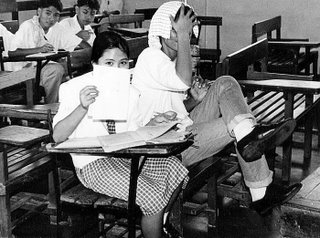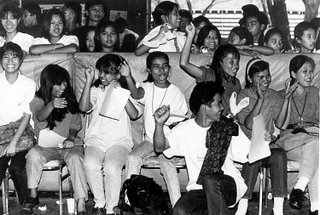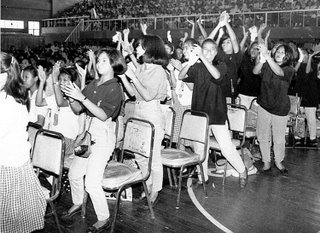| Update as of September 18, 2023:
If you’re a high school or grade school student in the Philippines who’s joining the photojournalism contest in the division, regional, or national press conference, I’m offering two free resources to you : A. 900-plus interactive exercises on English grammar, vocabulary, reading comprehension, verbal analogy, etc (with around 200 megabytes total file size). The exercises have time limit and automatic scoring, with an average of 10 items per exercise. Examples of these interactive exercises are: Common English grammar errors: Exercise 01 (nouns - confusions of number); Phrasal Verbs: Expressions with Go; English Placement Test (45 items). B. 200-plus resources (JPG, PDF, MP4, etc.) on photography and photojournalism, with 600-plus megabytes total file size. For some examples of these resources, surf to the “Free photography e-books, cheat sheets” page. For the download links and more information about how to use the interactive exercises, please surf to my “Better English resources and exercises” blog. Please inform your journalism teacher/schoolpaper adviser or your parents about these resources before downloading them. If you have any question about downloading or using these free resources, please email me (after informing your journalism teacher/schoolpaper adviser or your parents). I’ll be able to reply to you within two to three days; if you don’t see my reply in your Inbox, check your Spam folder. Or, you can text me. Atty. Gerry T. Galacio gtgalacio@yahoo.com 0927-798-3138 |
How to write photo captions
Captioning (in English or Filipino) is a part of the photojournalism competitions in the district, division, regional, and national press conferences. Posted below are three videos that explain how to write captions; the 2nd video is the most comprehensive, with its guidelines essentially repeated in the 3rd video. (Note, however, that in professional newspaper work, a photojournalist writes the preliminary caption, but the final caption is usually written by the desk editor.)
Other YouTube videos on captioning: Journalism Style Guide: Caption Basics; Writing Captions; Caption Writing Examples and Exercises; Captioning (Photojournalism)
PDF resources on captioning: ABCs of Caption Writing - Yearbook Besties; 1Y - Yearbook Caption Writing (24 points possible); Caption writing - La Salle University; Writing Great Captions - Canyon yearbook; Creating Captivating Captions (from online discussion/flip book)
Articles on captioning: How to write a good photo caption; How to Write and Use Photo Captions; How to Write Good Captions in Photojournalism; How to write a caption (with audio); How to Write Captions for Your Photos
Campus news photography and working on your yearbook
 “High school, the best years of our lives, except for the days spent in math class!”
“High school, the best years of our lives, except for the days spent in math class!” Just kidding, okay? Lighten up! I hope math nerds or math lovers among you out there won’t take offense over all these things I’ve said about math. But I must admit I’m not really good with numbers; I’m probably better at cross-stitching than at algebra ... Just kidding, okay? Lighten up! Actually, math and other related disciplines can be a lot of fun.
As I explained in the introduction to this series on photojournalism, I’ve used the term “photojournalism” in a rather loose but restricted way. Loose because photojournalism is the application of photography to a class of events people would classify as news (the topics we have discussed however are the basics, the foundations of photography). Restricted in the sense that I have limited the term to “campus news photography.”
Campus news events: hard news and soft news
In practical terms, the following may be considered as campus news events:
- programs
- stage presentations
- speech festivals
- graduation
- PTA meetings
- awarding ceremonies
- club elections
- academic contests
- practices
- demo classes
- intramurals
- alumni homecomings
- classroom events
- book presentations
- community outreach activities.
Classroom dramas
An often neglected aspect of campus news photography is classroom dramas. That’s understandable because the schoolpaper photographers have their own classes to attend. But, as the examples below show, classroom dramas provide a rich source of pictures not only for your schoolpaper but, more importantly, for your yearbook.



Watch the practices or rehearsals
 I have emphasized several times in this series the importance of watching the practices or rehearsals for any activity. If you don’t watch the practices for choral recitation contests or field demonstrations, for example, you won’t know which action, which formation would be good to shoot. You’ll be caught unprepared, and the most “photogenic” moments or actions could zip by you in seconds.
I have emphasized several times in this series the importance of watching the practices or rehearsals for any activity. If you don’t watch the practices for choral recitation contests or field demonstrations, for example, you won’t know which action, which formation would be good to shoot. You’ll be caught unprepared, and the most “photogenic” moments or actions could zip by you in seconds.
When you’re taking candid shots of your fellow students around the school campus, you’ll find it difficult at first in getting natural looking, candid reactions (like those of the shy sweethearts in the picture above). Your fellow students will naturally be conscious of you and your camera. But as time passes by, your schoolmates (like the CAT cadets below) will get used to you and your camera, and they won’t mind having their pictures taken. This way, you’ll get more relaxed, more natural looking expressions and reactions.

Archive your photos
| Update as of March 15, 2020: You can use the various free cloud services like Google Drive or Dropbox to archive your photos. |
These pictures (or image files) will constitute your stock photos. If you need a picture as filler for a certain article in your schoolpaper, you can just pick an appropriate picture from your stock. If you can’t watch a practice or rehearsal, you can review your stock photos. This will also help you in deciding how to vary your coverage of an event or program.
Provide the context for your photo coverage
In covering any event, don’t just concentrate on the actual event. Shoot the practices, the preparation of the props, the participants on their way to the venue, etc. When the winners are announced, turn around immediately to shoot the reaction of the audience or spectators (like in the pictures below). Shoot the jubilant winners, shoot especially the sore losers.


In covering events, be aware also of the various photo opportunities provided by the spectators, like these two girls (below) wearing masks and watching from the sidelines.

Working on your yearbook
The most tangible souvenir of your high school or college days is the yearbook, and you should therefore exert all efforts to make it really memorable. The sad fact, however, is that, for most schools, the yearbook is a tradition-bound publication. Don’t get me wrong, there’s nothing wrong with a lot of traditions. But you’ve got to admit, there isn’t much difference with the yearbooks your school publishes from year to year. Once you’ve seen one yearbook, you’ve seen them all.
Of course, some things you expect to see in any yearbook — individual pictures for private schools, class pictures for public schools, messages, directories, etc. But the challenge is to produce a yearbook that contains not only all the “traditional” materials but also new materials and new designs that will make your yearbook stand out from the rest.
Coming up with a better yearbook requires, first of all, a rethinking about what it should be. Traditionally, a yearbook is meant only to contain pictures of the graduates and not much else. My idea is that a yearbook should be a summation of your whole stay in high school or college. A yearbook therefore should not only have lots of good pictures to look at but also a lot of good articles to read. In practical terms, this would mean including pictures of all school activities and candid pictures from first year to fourth year, poems, feature articles, interviews with outstanding class personalities, etc.
Conceptual approach to campus publications

As I told you in the introduction to this series on photojournalism, I worked as journalism teacher and schoolpaper adviser in Quezon City Science High School in 1983-84 and in Rizal High School from 1984 up to 1996. The picture above shows some of the yearbooks I edited for Rizal High School. With all these yearbooks, I have always followed what I have called the “conceptual approach” to publications. By this I mean, a certain theme, idea or concept determines the overall design and layout, the pictures and articles to be placed in the yearbook. For example, for the 1990 yearbook I worked on, the concept was “Roots” and by this I meant, what’s the root, the source of being or identity for the student? The family, the group of friends ... What’s the root of the family? The community, the country ... In practical terms, I included pictures of the parents and siblings of the valedictorian and salutatorian. There were also interviews and pictures of the wholesome “barkadas” among the graduates. Pictures of the community were included as fillers.
In l993, I came up with “A Sense of History” as the concept. Pictures of our school and students from the 1920s up to the l940s were included in the yearbook. The list of the valedictorians and salutatorians from previous years were included on the pages allotted for that year’s top honor students. A special feature was that of a member of Class ’73 (that’s me!) looking back in nostalgia, 20 years after high school. Other concepts ? “A Brave New World” (1992), “The Circle of Life” (1995), and “Individuality” (1996).
A lot of schools follow what I call the “shotgun” or “scattershot” approach. They simply bundle or mix and match all the pictures and articles in a certain publication without coming up first with a single controlling theme or concept. Why use the word “shotgun,” you might ask?
Well, if you use a shotgun, it scatters pellets all over the target. There isn’t a single hole but a lot of holes. Meaning, publications which follow the “shotgun” approach lack unity, emphasis, or, as Edgar Allan Poe described it, a “single dominant impression” that sticks in the minds of the readers.
My point is, you and your fellow staffers should bump heads together to come up with a theme or concept that would control the articles and the design of your yearbook.
The concept, however, is not meant to be a straitjacket to completely stifle your creativity. Even if a certain picture or article does not completely fit with the concept, you may still use it. As long as there’s some relevance, use it!
Practical suggestions for your yearbook
Besides coming up with a concept before beginning to work on your yearbook, here are some practical suggestions I’d like to pass on to you.
1. Don’t use fancy borders for your yearbook portraits. Some people think that the fancier the borders they use, the better their yearbooks would be. Ehh! Totally wrong! Fancy borders take attention away from the portraits. Use simple line borders or drop shadows. Avoid oval shaped portraits; they’re simply outdated.
2. For schools which use class pictures instead of individual pictures, avoid having wide rows. If they’re too wide, you’ll have lots of empty, wasted spaces at the top and /or bottom portions. Remember our discussion on shooting groups and the steps in shooting class pictures? Remember filling the frame?
3. A lot of private schools love cutting up and grouping pictures of activities into shapes like hearts, birds or some other fancy shapes. What can I say without being unkind? These designs are amateurish; furthermore, these fancy shapes take attention away from the pictures which should stand on their own.
4. Here’s something I really, really hate to see in a yearbook or any publication. Some staffers or advisers love using lots of fonts in a single page or in one whole publication. Sometimes, there will be 3 to 5 fonts in a page - Banff for the headline, Times Roman for the text, Casper Open Face for the subheads ... These people believe that the more fonts they use on a page, the better looking their publication would be. Ehh! Absolutely wrong!
Read books on page layouts or typographic designs and they’ll tell you, simply use one or two fonts per page or publication. What I usually do in terms of headlines is this: Poster Bodoni (or any other selected font) all throughout the publication but with certain variations (italics, all caps, caps and lower case, fit text to path, outlines or drop shadows). In this way, I can get variety and unity at the same time.
5. How long does it take to do a yearbook? If materials are complete, 45 to 60 days would be more than enough for the printing press to finish it. But you and your fellow staffers have to go to press almost every day. Some private schools get their yearbooks several months or even years after graduation because they just leave all the work with the press, which takes its own sweet time doing the work. It’s your yearbook, work on it!





